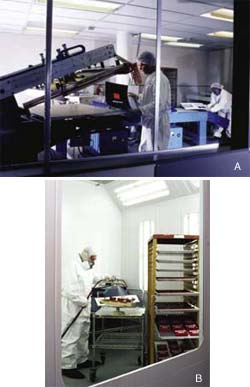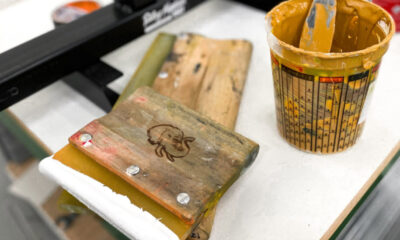Articles
Published
11 years agoon

Many screen printers assume that proper off-contact distance alone is the key to successful printing. It’s true that off-contact permits the mesh and stencil to release from the ink printed onto the substrate, but it is just one component of a larger influence on print quality: screen lift-off. Read on to find out more about this important facet of print quality.
Lift-off force and behavior
Many screen printers assume that proper off-contact distance alone is the key to successful printing. It’s true that off-contact permits the mesh and stencil to release from the ink printed onto the substrate, but it is just one component of a larger influence on print quality: screen lift-off. Read on to find out more about this important facet of print quality.
Lift-off force and behavior
Unlike off-contact distance, lift-off force can’t be measured accurately or set on a screen-printing press. You must rely on experimentation and experience to help you balance off-contact and a number of other variables to achieve the ideal lift-off force. A screen’s lift-off behavior is determined by the lift-off force of the screen and a counterforce. These forces, however, are influenced by particular variable in the printing process, including off-contact distance, screen size, mesh elasticity and tension, and size of the image area relative to the screen size (inside dimensions).
The counterforce to lift-off force is determined by the following variables: ink viscosity, amount of ink deposited on the substrate, size of mesh openings, adhesive attraction of ink to the screen mesh, adhesive attraction of the ink to the substrate, absorption capacity of the substrate, and squeegee speed.
Lift-off speed and angle
Under ideal lift-off conditions, the screen releases the ink immediately behind the squeegee during the print stroke (Figure 1). In other words, the lift-off velocity of the screen (Va) is identical to the velocity of the squeegee (Vs). By adding the off-contact height (h) and length of the print stroke (L), we can describe the printing process according to the following equation: Va/Vs = h/L. However, this equation alone is still an incomplete representation of the influences on lift-off, including screen elasticity (E) and the lift-off angle (θ) formed by the off-contact height and length of the print stroke.
When you use a relatively steep lift-off angle and high squeegee speed, the ink tears off because it has insufficient time to transfer onto the substrate. The result can be incomplete image transfer or, in extreme cases, no image transfer at all. In general, excessively steep lift-off angle and/or relatively high squeegee speed lead to poor printing results. Be aware that the cohesive nature of an ink—the tendency of the ink to stick together—and its adhesive affinity for the mesh and substrate also affect ink release.
When the lift-off angle is too low, the elasticity of the screen mesh is incapable of overcoming the lift-off counterforces. The result is that an area of the mesh exhibits delayed lift-off as it sticks to the substrate. This sticking area is immediately behind the squeegee during the print stroke. If the lift-off force is less than the counterforce of ink sticking to the mesh and substrate in the sticking area, the length of this sticking area is described by the ratio of these forces. Such delayed lift-off always leads to printing faults.
Parallel off-contact distance
Parallel off-contact distance is a technique printers often use. When using parallel off-contact, the lift-off angle near the beginning of a print stroke is always larger than the lift-off angle further along the print stroke. The lift-off angle decreases over the length of the squeegee stroke. In fact, every time you double the length of the squeegee stroke, you reduce the lift-off angle by half.
One way to minimize the discrepancy between screen angles when printing with parallel off-contact is to increase the size of the screen relative the size of the image area. Increasing the distance between the top inside edge of the screen and the beginning of the image area will help you avoid the high initial lift-off angle and reduce the difference between the angles at the beginning and end of the image area. However, you might also have to increase off-contact height, which could cancel out the benefit of using the larger screen by again making the lift-off angle too steep at the beginning of the image area.
Printing with parallel off-contact leads to lift-off problems and, consequently, to poor print quality, which is why many press manufacturers offer sophisticated peel systems on their equipment. These systems lift the rear of the screen as the squeegee moves along the print stroke. Peel systems maintain a constant lift-off angle over the length of the print stroke by raising the end of the screen during the squeegee stroke. The use of an automatic peel system requires the press operator to set minimum off-contact and maximum screen-lift heights. The optimum heights are those that cause the lift-off angle to remain constant over the full length of the squeegee stroke.
The influence of ink, off-contact, and mesh tension
Off-contact distance and mesh tension are measurable, but ink viscosity as a counterforce cannot be measured. The behavior of the ink as a counterforce relates more to its tack (stickiness) than its viscosity. Ink viscosity manifests itself as a certain degree of tack during printing and varying degrees of tack in the printed ink deposit.
The tack characteristics of the printed ink are determined by the height of the ink deposit, the thixotropic state of the ink, drying rate, and adhesive attraction for the substrate. In general, a good rule to follow when considering the lift-off force required for a job is that medium- to high-viscosity inks require medium to high lift-off forces.
Keep in mind when setting off-contact that doubling off-contact distance quadruples printed-image distortion. For example, if you print an image with an off-contact distance of 4 mm, and the image becomes elongated by 0.1 mm, then doubling the off-contact distance to 8 mm will cause image elongation of 0.4 mm.
Also consider that doubling the off-contact distance or mesh tension doubles the lift-off force of the screen. Therefore, if you double off-contact distance and mesh tension, you get a four-fold increase in lift-off force. Table 1 shows how off-contact distance and mesh tension influence the lift-off force required to overcome the ink-tack counterforce. We can’t measure ink tack, so this table represents the force of ink tack on a scale from 1-5, where values of 1-2 are for no-tack to low-tack inks, 2.5-3.5 for medium-tack inks, and 4-5 for high-tack inks.
Accommodating close-tolerance printing
Off-contact distance should always be as low as possible so that you can meet requirements for close-tolerance printing without risking image distortion, poor registration, incorrect ink deposit, and short stencil life. But don’t exceed the screen’s maximum tension level, which is influenced by the size of the screen frame, the bending strength of the frame, the type of stretching device you use, and the tensioning method you prefer.
If you need to take ink tack into account for a job with strict requirements for image length and positional accuracy and the mesh tension is too low to provide the proper lift-off force, you may be able to assist the lift-off behavior by reducing the squeegee speed during the print stroke.
If reduced squeegee speed doesn’t solve the problem, your next option is to use a film positive or negative that is corrected to compensate for image distortion on press. Distortion positives or negatives are produced by entering the empirical distortion values into the software used to create the artwork or into the output device prior to generating the film. Another option is to use a larger screen size or a decreased image area, which reduces the width and length of the squeegee stroke relative to the screen size.

Subscribe

Magazine
Get the most important news
and business ideas from Screenprinting Magazine.
Most Popular
-

 Art, Ad, or Alchemy1 month ago
Art, Ad, or Alchemy1 month agoF&I Printing Is Everywhere!
-

 Case Studies1 month ago
Case Studies1 month agoHigh-Density Inks Help Specialty Printing Take Center Stage
-

 Andy MacDougall1 month ago
Andy MacDougall1 month agoFunctional and Industrial Printing is EVERYWHERE!
-

 Columns2 weeks ago
Columns2 weeks ago8 Marketing Mistakes Not to Make When Promoting Your Screen Printing Services Online
-

 Editor's Note2 weeks ago
Editor's Note2 weeks agoLivin’ the High Life
-

 Thomas Trimingham2 months ago
Thomas Trimingham2 months ago“Magic” Marketing for Screen Printing Shops
-

 Marshall Atkinson2 weeks ago
Marshall Atkinson2 weeks agoHow to Create a Winning Culture in Your Screen-Printing Business
-

 News & Trends1 month ago
News & Trends1 month agoWhat Are ZALPHAS and How Can You Serve Them in Your Print Business?






